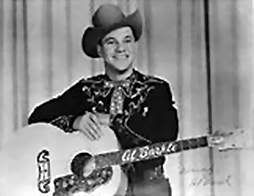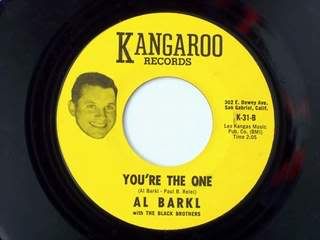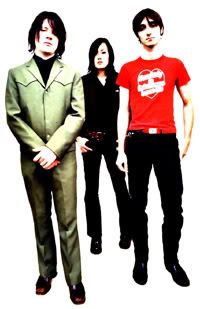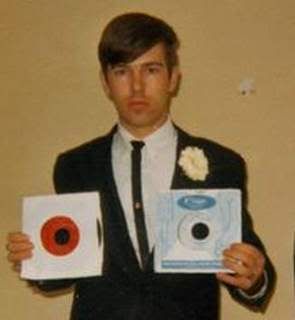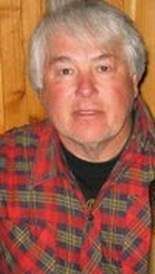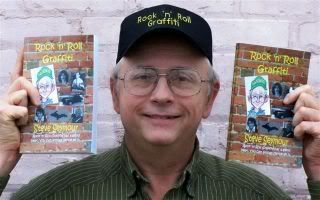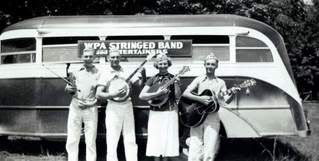
WPA Stringed Band members
By STEVE SEYMOUR
A little known chapter in Delta County history tells how a group of young people softened the harsh realities of the Great Depression by taking up musical instruments to entertain the public.
The story is told in an old scrapbook put together years ago by Joseph Bussineau, who ran a music program in Flat Rock for the Works Progress Administration.
Created in April, 1935, the WPA was the largest agency in President Franklin Roosevelt's New Deal program, employing millions of people, especially in rural areas.
Bussineau was charged with teaching young people, who had no previous music training, to play a variety of stringed instruments such as violin, mandolin and banjo.
He took to his new assignment with relish.
The local program was started in early 1936 when large numbers of eager young music students began to congregate at Bussineau's residence in Flat Rock.
Soon, his basement became a studio where the aspiring musicians were taught in groups every night of the week, beginning at 7 p. m.
After just six months of instruction, the youths began to make public appearances all around the area. Publicity at the time said the band could be "obtained to play at any entertainment program in Delta County without charge, provided no admission is charged by the sponsors. Any club, organization or church desiring the services of this organization is asked to call."
An early appearance took place at the Bark River community building on Thursday June 18, 1936.
The public, desiring to forget about the economic hardships of the time, responded with enthusiasm.
Early on, the band included 86 pieces, then 150, and finally over 200 youngsters participated. The students broke into smaller groups to entertain at various events such as social club meetings and civic celebrations.
While the group made dozens of public appearances to entertain the weary public, Bussineau noticed another benefit. "It is one way to deal with the child delinquency problem. Give the children something to do in which they are interested and you will have no trouble. In my musical training work, I have found it easy to get the youngsters to give attention to every demand made upon them," a newspaper article quoted him as saying at the time.
Billed as the WPA String Band of Flat Rock, but also called the Junior Music Club, the group entertained crowds at the Labor Day picnic at Gladstone City Park on Sept. 7, 1936. 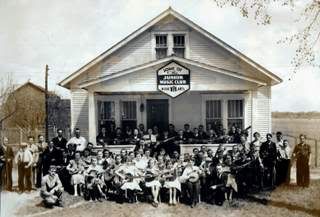
Joseph Bussineau residence
A large group of participants was photographed in front of Bussineau's residence one Sunday afternoon, 96-year-old Bill Charlebois recalled. A sign posted on the house, identifying it as "Home of the Junior Music Club," was made by Bussineau for the occasion, Charlebois remembered.
Paging through Bussineau's scrapbook reveals what popular entertainers his students became. An old ticket revealed the group held its 50th performance at Flat Rock town hall on Wednesday, Dec. 15, 1937. The event, which included "movies, music and entertainment," was free of charge.
The group's fame even extended to the airwaves. Although Escanaba didn't have a commercial radio station at this time, Bussineau approached the management of Marquette's WBEO, owned by Lake Superior Broadcasting Co., for consideration. Manager Gordon H. Brozek granted 15 minutes of air time, beginning at 10 a. m., Sunday, June 4, 1939.
Bussineau's daughter, Frances Bougie, now 80, remembers the occasion distinctly.
Notes in Bussineau's scrapbook testify that the program was well received. "Just wanted to compliment you on the fine program broadcast over WBEO last Sunday. Many of my friends and myself would like to have you broadcast often," wrote George Henricks. "Heard your very enjoyable program over WBEO Sunday morning. Please let us hear from you again soon," stated Mr. and Mrs. Oral Thompson Sr. Added M. Levesque: "I listened to your program on Sunday and enjoyed it a lot. I only wish you'se (sic) would be able to get a program every week. Every number sounded good and believe me I think it was grand."
Despite the favorable response, Mrs. Bougie said she thought it was the only time the group was broadcast on radio. One of the final performances was at the second annual U. P. Townsend Rally and Picnic, held Sunday, Aug. 4, 1940 at the fairgrounds in Escanaba.
As the WPA music program ended, Bussineau worked for Meiers Signs. He was later in charge of the State Highway Department Sign Shop in Escanaba. He died in 1974.
Because Bussineau was careful to paste dozens of newspaper clippings, letters, programs and photographs into a scrapbook, a little known chapter of local history has been preserved.
